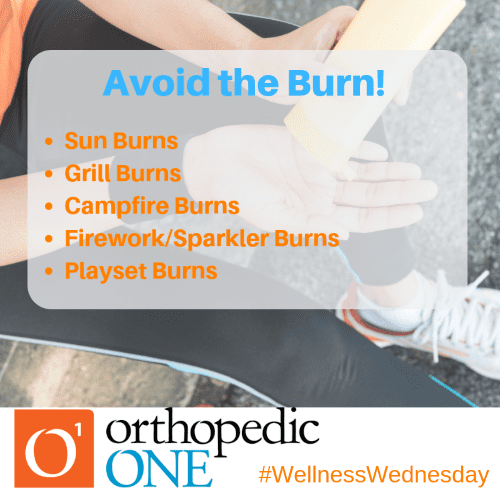Avoid the Burn!
While summer presents us with an array of opportunities to participate in outdoor activities, it is also a time when burn incidences are on the rise. From a classic summer sunburn to a burn that is the result of trying to cook a burger to perfection over the grill. Or a burn from roasting marshmallows over the campfire to an accident involving sparklers at a cookout or on a camping trip.

Regardless of how it happens, burns are quite uncomfortable, but luckily can be prevented by following a few simple precautions:
Sun Burns
- Use sunscreen any time you will be outside for prolonged periods of time.
- Apply sunscreen 15 minutes prior to going outdoors.
- Slather it all over! Most people only apply 25-50% of the recommended amount of sunscreen.
- Sunburn can occur in less than 15 minutes, but the harm is often not immediately obvious.
- After the exposure, skin may turn red in as little as 30 minutes, but most often takes 2-6 hours. Pain is usually most extreme 6-48 hours after exposure. The burn continues to develop for 24-72 hours, sometimes followed by peeling skin in 3-8 days.
Grill Burns
- Make sure children are supervised around grills or open flames. According to the National Fire Protection Association, “Children under five accounted for an average of 2,000 or 38%, of the contact-type burns per year. These burns typically occurred when someone, often a child, bumped into, touched or fell on the grill, grill part or hot coals.”
- Between 2013-2017, an average of 19,000 patients per year went to emergency rooms because of injuries involving grills. Of these, about half (9,300 or 49%) of the injuries were thermal burns, including both burns from fire and from contact with hot objects. 5,200 thermal burns per year were caused by such contact or other non-fire events.
Campfire Burns
- Most injuries from campfires are the result of touching embers or coals, rather than from actual flames.
- When visiting camp sites or walking on beaches where fires are permitted, be sure to steer clear of fire pits and wear appropriate footwear when walking where fires might have been. Fire pits retain heat for up to 12 hours after being extinguished.
Firework & Sparkler Burns
- Even though the Fourth of July has passed, sparklers can always add bit more fun to a family bonfire or camping trip. Always have a sober adult supervise fireworks activities.
- Parents, pay close attention if your children are near sparklers. While they may not seem too threatening, sparklers burn at temperatures of about 2,000 degrees, which is hot enough to melt some metals!
- Here are a few guidelines to follow when breaking out the sparklers!
Playground Burns
- Playgrounds are the perfect place to take children to let off steam and release some energy, but even when the outside temperatures only reach around 80⁰ F, some parts of the playground can reach almost double that temperature.
- Before you let your children loose at the playground, be sure to test the temperature of the equipment by placing the back of your hand briefly on the material. If it’s too hot for you, it’s definitely too hot for your little ones!
Burn Treatments
There are three classifications of burns:
- Type 1: Involve the top layer of skin. Sunburns are a common type of 1st degree burn.
- Type 2: Involve the first two layers of skin.These types of burns are usually associated with blisters or a glossy appearance of the skin.
- Type 3: Penetrates the entire thickness of the skin and permanently destroys the tissue. Type 3 burns themselves are usually painless, except for the associated Type 1 and 2 burns that often accompany Type 3 burns.
Most first degree burns can be treated at home. However, those who sustain second and third degree burns should seek further medical treatment.
Sources: Ameribun, American Academy of Dermatology, CBS News, Medical News Today, National Fire Protection Association, National Program for Playground Safety, Playground Medic, United States Consumer Product Safety Commission